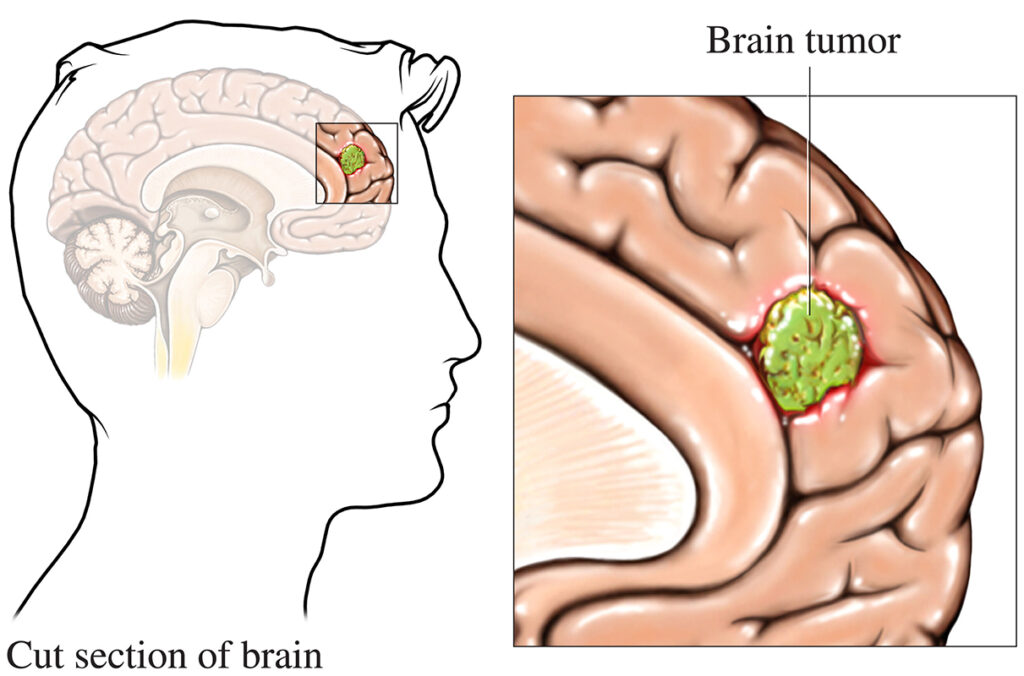
A brain tumor is an abnormal growth of cells in or around the brain that can be benign (non-cancerous) or malignant (cancerous). Brain tumors can have a profound impact on a person’s physical, cognitive, and emotional well-being. Early diagnosis and treatment are essential for improving outcomes. If you or a loved one is diagnosed with a brain tumor, seeking medical care at an advanced facility such as Peerless Hospital Kolkata can provide access to specialized treatments and cutting-edge technology. In this post, we’ll explore the types of brain tumors, their causes, symptoms, diagnosis, and treatment options.
Types of Brain Tumors
Brain tumors are classified into two main categories: primary and secondary tumors.
- Primary Brain Tumors: These originate in the brain or its surrounding tissues, such as the membranes, blood vessels, and nerves. Primary tumors can be:
- Benign Tumors: Non-cancerous tumors that grow slowly and don’t spread to other parts of the body. Examples include meningiomas and schwannomas.
- Malignant Tumors: Cancerous tumors that grow rapidly and can invade nearby brain tissue. Gliomas, astrocytomas, and oligodendrogliomas are examples of malignant brain tumors.
- Secondary (Metastatic) Brain Tumors: These tumors are the result of cancer spreading to the brain from another part of the body, such as the lungs, breasts, or kidneys. Metastatic tumors are always malignant.
Causes of Brain Tumors
The exact cause of most brain tumors is still unknown. However, several risk factors have been identified that may contribute to the development of a brain tumor:
- Genetic Factors: In some cases, genetic mutations or hereditary conditions can increase the risk of developing brain tumors. Conditions such as neurofibromatosis, Li-Fraumeni syndrome, and von Hippel-Lindau disease are associated with a higher likelihood of brain tumors.
- Radiation Exposure: People who have been exposed to ionizing radiation, such as radiation therapy for previous cancers, may have a slightly increased risk of developing a brain tumor later in life.
- Environmental Factors: Although research is ongoing, some environmental factors, including prolonged exposure to chemicals or toxins (such as those in certain industries), may contribute to brain tumor development.
- Age and Gender: Brain tumors can occur at any age, but certain types of brain tumors are more common in specific age groups. For example, medulloblastomas are more common in children, while meningiomas tend to occur more frequently in older adults. Some brain tumors are also more common in men than women.
- Family History: Having a family history of brain tumors or genetic disorders that predispose individuals to tumors can increase the likelihood of developing a brain tumor.
Symptoms of a Brain Tumor
The symptoms of a brain tumor depend on its size, location, and rate of growth. Since different parts of the brain control different functions, a tumor in one area may cause very different symptoms from a tumor in another area. Common symptoms of brain tumors include:
- Headaches: Persistent or severe headaches, often worse in the morning or when bending over, can be a sign of increased pressure in the brain caused by a tumor.
- Seizures: Brain tumors can disrupt electrical activity in the brain, leading to seizures. Seizures can manifest in various ways, such as involuntary movements, loss of consciousness, or convulsions.
- Cognitive or Behavioral Changes: Tumors in the brain can affect memory, concentration, mood, and personality. Patients may experience confusion, difficulty understanding language, or sudden changes in behavior.
- Vision or Hearing Problems: Depending on the location of the tumor, vision problems (such as blurred vision or double vision) or hearing loss may occur.
- Weakness or Numbness: A brain tumor can press on nerves, leading to weakness, numbness, or paralysis on one side of the body.
- Nausea and Vomiting: Increased pressure in the brain can cause persistent nausea and vomiting, particularly in the morning.
- Balance and Coordination Issues: Tumors affecting the cerebellum or brainstem can cause difficulty walking, maintaining balance, or coordinating movements.
It’s important to note that these symptoms can also be caused by other medical conditions, so experiencing them does not necessarily mean you have a brain tumor. However, if symptoms persist or worsen, it’s crucial to consult a healthcare provider for evaluation.
Diagnosis of a Brain Tumor
If a brain tumor is suspected, a thorough evaluation will be conducted to diagnose the condition. The diagnostic process usually involves several steps:
- Neurological Examination: A doctor will assess the patient’s vision, hearing, balance, reflexes, and coordination to identify any neurological deficits.
- Imaging Tests: The most common imaging tests used to diagnose brain tumors are magnetic resonance imaging (MRI) and computed tomography (CT) scans. These tests provide detailed images of the brain, allowing doctors to locate and measure the tumor.
- Biopsy: In some cases, a biopsy (removal of a small tissue sample) may be required to determine whether the tumor is benign or malignant. A biopsy can be performed during surgery or through a needle guided by imaging techniques.
- Other Tests: Depending on the situation, additional tests such as positron emission tomography (PET) scans, lumbar punctures (spinal taps), or blood tests may be performed to gather more information about the tumor.
Treatment of Brain Tumors
The treatment of brain tumors depends on several factors, including the type, size, location, and grade of the tumor, as well as the patient’s overall health. Treatment options for brain tumors include:
- Surgery: Surgical removal of the tumor is often the first step in treatment, especially if the tumor is accessible and can be removed without damaging critical areas of the brain. The goal of surgery is to remove as much of the tumor as possible while preserving brain function.
- Radiation Therapy: Radiation therapy uses high-energy rays to destroy cancer cells. It is often used after surgery to target any remaining tumor cells or in cases where surgery is not possible. Radiation can be delivered externally or through internal implants.
- Chemotherapy: Chemotherapy uses drugs to kill cancer cells. It is typically used in combination with other treatments for malignant brain tumors. Chemotherapy can be administered orally, intravenously, or directly into the cerebrospinal fluid.
- Targeted Therapy: Targeted therapies are designed to attack specific molecular changes in cancer cells that help them grow. These therapies can be used in certain types of brain tumors to improve treatment outcomes.
- Immunotherapy: Immunotherapy helps the body’s immune system recognize and attack cancer cells. While still being studied, immunotherapy holds promise for treating some brain tumors.
- Supportive Care: Managing symptoms and maintaining quality of life is an important aspect of brain tumor treatment. Supportive care, including medications for pain, seizures, and swelling, is provided alongside treatments aimed at removing or shrinking the tumor.
Prognosis and Recovery
The prognosis for brain tumor patients depends on various factors, including the type and grade of the tumor, the patient’s age, and the success of treatment. While some brain tumors can be cured or managed effectively with treatment, others may be more challenging to treat.
Recovery from a brain tumor requires a multidisciplinary approach, including rehabilitation to regain lost functions, such as speech, movement, or memory. Physical, occupational, and speech therapy may be part of the recovery process.
Conclusion
A brain tumor is a complex condition that requires prompt medical attention for proper diagnosis and treatment. While the journey can be challenging, advanced medical facilities like Peerless Kolkata offer cutting-edge technology and expert care for individuals facing brain tumors. By understanding the symptoms, causes, and treatment options, patients and their families can navigate the treatment process with greater confidence and hope for a positive outcome.



